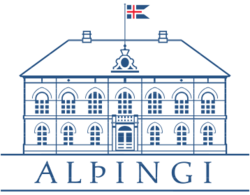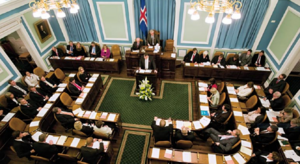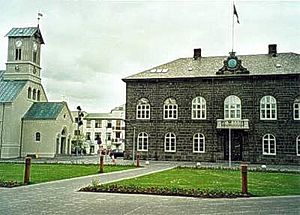Althing facts for kids
Quick facts for kids Icelandic ParliamentAlþingi Íslendinga |
|
|---|---|
| Members | |
 |
|
| Type | |
| Type | |
| History | |
| Founded |
|
| Leadership | |
|
Þórunn Sveinbjarnardóttir, Social Democratic Alliance
Since 4 February 2025 |
|
| Structure | |
| Seats | 63 |
 |
|
|
Political groups
|
Government (36)
Opposition (27)
|
| Elections | |
| Open list proportional representation | |
|
Last election
|
30 November 2024 |
|
Next election
|
By 30 November 2028 |
| Meeting place | |
 |
|
| Alþingishúsið, Reykjavík | |
The Alþingi, also known as the Althing, is the main national parliament of Iceland. It is famous for being the oldest parliament in the world that is still active today. The Althing was first started way back in 930. It met outdoors at a place called Þingvellir, which means 'assembly fields'. This spot is about 45 kilometers east of Reykjavík, Iceland's capital city.
For a long time, the Althing helped govern Iceland. But in 1262, Iceland joined with Norway. This meant the Althing lost its power to make laws. It didn't get this power back until 1904, when Iceland gained some independence from Denmark. For over 600 years, the Althing was not the main law-making body. Even so, it continued to meet at Þingvellir until 1800, when it was stopped completely.
The Althing was brought back in 1844 by a royal order. It then moved to Reykjavík. At first, it had one main group of members, but later it had two or even three groups. Since 1991, it has gone back to having just one main group of members. The building where the parliament meets today, called the Alþingishús, was built in 1881. It's made from special Icelandic stone.
Today, the Althing has 63 members. These members are chosen every four years in elections. The way they are chosen makes sure that smaller political groups also get a fair chance to have their voices heard. The current Speaker of the Althing, who leads the meetings, is Þórunn Sveinbjarnardóttir. She has been in this role since February 2025.
Contents
How Members Are Elected
Iceland's constitution divides the country into six areas called constituencies. Each constituency elects a certain number of members to the Althing. No constituency can have fewer than six members.
The election system also tries to be fair to all political groups. If a political group gets more than 5% of all the votes in the country, they get extra seats in the Althing. This helps make sure that the number of members each group has in parliament matches how many votes they received overall. The Icelandic National Electoral Commission makes sure these rules are followed.
A Look Back at History
The Very First Parliament: 930–1262
The Althing is often called the world's longest-running parliament. It began around 930 as an outdoor meeting, or thing, held on the plains of Þingvellir. This was a big step for Iceland to become an independent nation.
At first, the Althing was a gathering for the most powerful leaders, called goðar. They met to create laws and settle disagreements. All free men could come to these meetings. They were often the biggest social event of the year! Many farmers, families, traders, and storytellers would gather. People would set up temporary camps during the sessions.
The most important spot was the Lögberg, or Law Rock. Here, the Lawspeaker (lögsögumaður) would sit. This person was in charge of the meeting and had to recite all the laws aloud. They also explained the rules for how the Althing worked each year.
In 930, the "Gulathing Law" was adopted. It was brought by Úlfljótr, who had studied laws in Norway.
A very important decision happened in the year 1000. According to an old story called Njáls saga, the Althing decided that Christianity would be the official religion of Iceland. There had been some disagreements about religion, and a leader named Thorgeir Ljosvetningagodi suggested having "one law and one religion" for everyone. This meant that becoming Christian was required by law.
The Lögrétta was the main law-making part of the Althing. It had 39 chieftains and other members, including the Lawspeaker. This group made new laws and helped solve legal problems. The old Althing also acted like a court, hearing many disputes.
Under Kings: 1262–1800
In 1262, Iceland agreed to be ruled by the King of Norway. This changed the Althing's role. The chieftains no longer ruled the country. Instead, the king and his officials were in charge.
The Lögrétta still existed, but it shared its law-making power with the king. Any new laws needed the king's approval. Later, Iceland came under the control of the Danish monarchy. When Denmark became an absolute monarchy (where the king had all the power), Iceland lost even more of its independence. After this, the Althing mostly worked as a court, settling legal cases, until it was closed in 1800.
A Break and a New Start: 1800–1845
The Althing was officially stopped by a royal order in 1800. A new High Court was created in Reykjavík to take over its court duties. This High Court worked until 1920, when the Supreme Court of Iceland was established.
Coming Back as Advisors: 1845–1874
A new royal order in 1843 brought the Althing back! Elections were held, and the new assembly met in Reykjavík on July 1, 1845. Some people wanted it to meet somewhere else, but Reykjavík was chosen.
This new Althing had 26 members. Only men who owned property and were at least 25 years old could vote. This was only about 5% of the population at the time. The Althing's job was to advise the king. It looked at new laws and discussed important issues. It helped improve laws and how the country was run.
Making Laws Again: From 1874 Onwards

In 1874, Iceland got a new constitution. This gave the Althing more power to make laws, working together with the king. The Althing also gained control over taxes and government spending. However, the king could still say no to laws passed by the Althing.
The number of members in the Althing grew to 36. It was divided into two groups: an upper chamber and a lower chamber. The current Parliament House, shown in the picture, was built in 1881.
Gaining More Control: Home Rule and Personal Union
In 1903, Iceland took another big step towards independence. A new rule gave Icelanders "home rule" and their own parliamentary government. This meant Iceland could manage many of its own affairs. Hannes Hafstein became the first Icelandic minister in 1904. He had to have the support of the Althing members.
Important changes were made to voting. In 1908, people started using a secret ballot instead of saying their vote aloud. This made elections fairer.
In 1918, the "Act of Union" made Iceland a sovereign state in a "personal union" with Denmark. This meant Iceland was an independent country, but it still shared the same king as Denmark. The Althing now had full power to make laws. The voting age was lowered to 21.
The Republic of Iceland

During World War II, Germany occupied Denmark in 1940. This made it difficult for Denmark to govern Iceland. So, the Althing took over full responsibility for Iceland's government.
On June 17, 1944, the Act of Union with Denmark was ended. The Republic of Iceland was officially established at a special meeting of the Althing at Þingvellir.
After becoming a republic, more changes happened. In 1959, the way electoral districts were set up changed. The voting age was lowered to 20 in 1968, and then to 18 in 1984.
In May 1991, a big change happened: the two chambers of the Althing merged into one. This made the Althing a single-chamber parliament again, which is how it is today. The number of members was set at 63. The system for constituencies was changed again in 2003, reducing them from eight to six.
Recent Elections
The Althing members are elected for a four-year term. Sometimes, a special election can be called earlier.
- 2013 Icelandic parliamentary election
- 2016 Icelandic parliamentary election
- 2017 Icelandic parliamentary election
- 2021 Icelandic parliamentary election
- 2024 Icelandic parliamentary election
Results of the 2024 General Election
The most recent general election for the Althing took place on November 30, 2024. Here are the main results:
- Social Democratic Alliance: 15 seats
- Independence Party: 14 seats
- Viðreisn: 11 seats
- People's Party: 10 seats
- Centre Party: 8 seats
- Progressive Party: 5 seats
Members of Parliament (Past and Present)
- List of members of the parliament of Iceland, 1983–1987
- List of members of the parliament of Iceland, 1987–1991
- List of members of the parliament of Iceland, 1991–1995
- List of members of the Althing, 1995–1999
- List of members of the Althing, 1999–2003
- List of members of the Althing, 2003–2007
- List of members of the Althing, 2007–2009
- List of members of the Althing, 2009–2013
- List of members of the Althing, 2013–2016
- List of members of the Althing, 2016–2017
- List of members of the Althing, 2017–2021
- List of members of the Althing, 2021–2024
- List of members of the Althing, 2024–2028
See also
 In Spanish: Alþingi para niños
In Spanish: Alþingi para niños
- Constituencies of Iceland
- Women in Iceland#Women's suffrage
- List of parliamentary assemblies of Iceland
- List of speakers of the Parliament of Iceland
- List of speakers of the Upper House of the Althing
- List of speakers of the Lower House of the Althing

